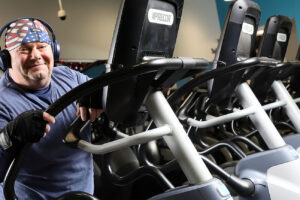A Severe Wrist Injury Won’t Slow Down Howell Resident
Brian Collins is a leftie. While that fact usually doesn’t impact his life much, it became a serious concern when he severed six flexor tendons, the flexor muscle, and the ulnar nerve in his left forearm, hand, and wrist.
Brian, a 44-year-old Howell resident, was walking up his front steps with a glass bottle when he tripped and fell on the shattered glass. His wife, Melissa, and her sister, a nurse, jumped into action to limit the bleeding. Brian was then rushed to CentraState Medical Center’s Emergency Department.
After a quick closure of the lacerations in the Emergency Department, Brian underwent surgery to repair his hand and wrist. But because his injury was so complex, his recovery was far from over.
Customized Occupational Therapy
Four days after surgery, Brian began occupational therapy three times a week at CentraState’s OceanFirst Rehabilitation Center. Lara Cohen, MSOT, CHT, a certified hand therapist, helped develop Brian’s therapy plan.
Armed with Brian’s operative report, Cohen was able to see where the injury was surgically repaired and could develop a customized treatment plan. The team worked to minimize pain and swelling and to protect the repaired structures through custom splinting.
The next phase focused on activities that would slowly and gently move his tendons, including fine-motor and gross motor coordination, strengthening the muscles in his wrist and hand, and completing basic self-care skills such as cutting food, holding a cup, and brushing his teeth.
“Brian has multiple sclerosis and diabetes, which further complicated the treatment process and delayed healing,” Cohen explains. “We developed a dynamic treatment plan that was continually re-evaluated and updated as Brian’s healing progressed. I also had the opportunity to direct any questions or concerns to his treatment team at CentraState’s Linda E. Cardinale MS Center, where he has been receiving ongoing care.”
Brian, who enjoyed playing guitar before his accident, ultimately wants to play again—a goal his caregivers believe is attainable. He’s also back to another hobby he loves: riding his motorcycle.
“This progress is a good example of what happens when you have a specialized team and a motivated patient working together,” Cohen says. “The better the communication, the better the results.”
“I can’t give enough praise to my team at CentraState,” Brian says. “They’ve done a great job in helping me through this and have kept me focused. It was scary as first, but now I can care for myself. I have a life again.”
For more information about CentraState’s rehabilitation and physical therapy services, call 866-CENTRA7 (866-236-8727).





